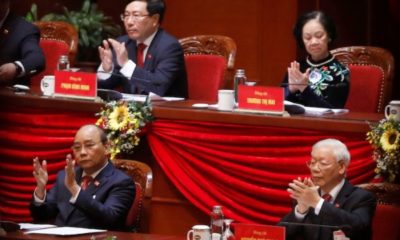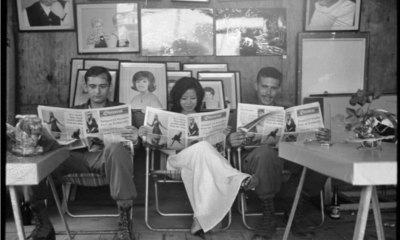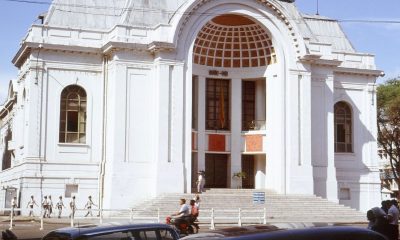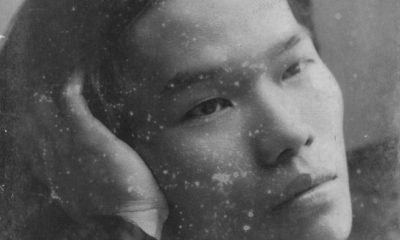Politics & Economy
Frustrated Nations: The Evolution of Modern Korea and Vietnam
Published on
By
Tuong Vu
Tuong Vu, University of Oregon
Acknowledgements:
This chapter was written under the auspices of the Democracy and Development Program, Princeton Institute for International and Regional Studies, Princeton University. I’m grateful to the Program and to its directors Atul Kohli and Deborah Yashar for their support. I’m also indebted to helpful comments from Donald Emmerson, Donald Keyser, James Ockey, T. J. Pempel, Gi-wook Shin, and David Straub on an earlier version.
Introduction
This chapter aims to identify and compare the major patterns of modern national and state evolution in Korea and Vietnam. Korea and Vietnam are located in the same geographical neighborhood. Both are (much) smaller neighbors of China and historically existed within the premodern Sinocentric cultural and political world. Premodern developments created an ethnically more homogeneous and politically more stable Korea than Vietnam. But their fates really began to diverge in the late 19th century despite apparent similarities. While both were colonized, Korea was colonized by a fellow Asian country (Japan) and Vietnam by a far-away Western one (France). Korea also became a colony decades later than Vietnam, and as a colony was ruled under a unified administration. In contrast, Vietnam was broken up into three administrative zones under different laws. While both countries were divided during the Cold War into communist and anti-communist states, Vietnam was reunified under communist rule after a long and extremely violent war. The North Korean communist state also attempted to reunify the country by force, but their war failed after three years of savage fighting. South Korea eventually became a rich and democratic country in contrast to poor and authoritarian North Korea and Vietnam. Interestingly, both Vietnam and South Korea have seen a strong resurgence of nationalism in the post-Cold War period. It is understandable that a still divided Korea frustrates many South Koreans, but why has a reunified Vietnam failed to satisfy Vietnamese patriots? The irony implied in the comparison between Vietnam and South Korea today brings to one’s mind Leo Tolstoy’s famous remark that “[h]appy families are all alike [but] every unhappy family is unhappy in its own way.”
Korea and Vietnam’s tortuous path to modernity might well have something to do with their “middle power” status. Both countries are of medium size and situated between great powers. While Vietnam lies between India and China, Korea shares land or maritime border with China, Russia and Japan. Both Vietnam and Korea are across the Pacific Ocean from the United States. Their middle-power status makes both geopolitically worthy for the great powers to fight over. At the same time, they themselves are big enough to dare to challenge the great powers, or to use Donald Keyser’s metaphor in the introductory chapter, to “punch well above their weights.” Barely emerging from colonial rule, both Korea and Vietnam found themselves exactly where the Iron Curtain fell, which was not entirely a coincidence. US military intervention in both countries was similarly not a coincidence. Both the Korean War (1950-53) and the Vietnam War (1965-73) were fought not only to contain the Soviet bloc but also to protect the US from facing communism on its borders. Lacking military capability but not ambitions, both North Korea and North Vietnam at that time chose to challenge the boundary imposed on them by the superpowers. Their pride of being outposts of the socialist bloc and their bravado to stand up to the US showed elements of middle powers’ behavior.
This paper will be divided into three main parts. Following a brief discussion of premodern history, the first part concerns the development of modern national consciousness in Korea and Vietnam since the 19th century. The second part compares the process of modern state building in North Vietnam and South Korea. The literature on the political system in North Vietnam is scarce, and I will use primary data from an ongoing research project. In the conclusion, I discuss the lessons of reunification in Vietnam for South Korea. While Koreans in divided Korea may look to unified Vietnam with envy, they should be aware of the cost of Vietnamese-style reunification that did not seem to have improved the lot of most Vietnamese.
Premodern Korea and Vietnam
Vietnamese and Korean relations to China in premodern times followed a similar course of initial subjugation and later independence. Today’s Vietnam originated as a tribal society in the Red River Delta. This society fell under Chinese rule in 111 BC and remained so until the 10th century. During this period, significant Chinese migration and intermarriage took place. Chinese culture was absorbed although the local culture retained certain elements distinguishable from Chinese culture. After regaining political independence in 938 AD, Vietnamese kings maintained a tributary relationship with China. They successfully resisted several invasions from the north, such as the Mongolian invasions in the 13th century. For two decades from 1400-1418, however, Vietnam fell under (Ming) Chinese direct rule. While the nationalist scholarship makes much of Vietnam’s “heroic resistance” against Chinese aggression, the premodern relationship between China and Vietnam was fundamentally peaceful and periods of war were rare.
Korea was also subject to direct Chinese rule from 108 BCE to the 4th century CE—only 400 years instead of 1,000 years as in Vietnam. Following the collapse of Chinese rule was the Three Kingdoms period of 300 years, during which three centralized kingdoms Koguryo, Paekche, and Silla competed for domination of the peninsula. Silla first collaborated with China to defeat its “Korean” rivals and later drove China out in 676. The subsequent tributary relationship between unified Korea and China was also marked by occasional conflicts as between Vietnam and China. Korean rulers also resisted many Chinese invasions, but fell under Mongol rule during 1270-1356.
Vietnamese history after independence from China was marked by much greater disunity and political tumult than Korean history. Korea was unified in the 7th century, never expanded its territory further, and underwent three dynasties before being annexed to Japan in 1910. In contrast, Vietnam’s territory gradually expanded to the south from the Red River Delta, conquering the Hindu/Buddhist Champa Kingdom (today’s central Vietnam) during the 12th-15th centuries and the Eastern part of the Hindu/Buddhist Khmer Empire (today’s southern Vietnam) during the 16th-18th centuries. Most of the territory of today’s Vietnam did not belong to it five centuries ago. During the 16th-18th centuries Vietnam witnessed two civil wars, first between Mac and Le houses (1527-1592), then between Northern Trinh, Southern Nguyen, and Tay Son lords (1627-1802), for a total of 240 years—about the same length in time with the Three Kingdoms period in Korea a millennium ago. What Silla achieved territorially in 676, the Nguyen dynasty, the 9th or 10th dynasty since Vietnam’s independence from China, achieved only in 1802.
Socially, another important difference between premodern Korea and Vietnam is the less hierarchical society in Vietnam. Vietnamese rulers were more successful than their Korean counterparts in eliminating the aristocracy by the 15th century. Nguyen’s Vietnam appeared more centralized than Yi’s Korea where the yangban (aristocrats) formed a powerful group rival to kings.
Culturally, Vietnam was deeply influenced by Buddhism, Confucianism, and neo-Confucianism like Korea. As late as the 19th century, traditional Vietnamese elites still did not imagine or define their world in ethnic terms (i.e. Vietnamese vs. Chinese), but in cultural ones as “domains of manifest civility.” This world contained political boundaries but was united under a single cultural framework which centered in the “Northern Kingdom” (today’s China) and to which “Southerners” (today’s Vietnamese) yearned to belong. Like in Korea, borrowing Chinese political concepts and institutions helped Vietnamese rulers consolidate their rule, and they were proud of being part of the Sinocentric cultural universe.
Rise of the modern nation in Korea and Vietnam
Compared to Korea, Vietnam’s geographic location exposed it to far more interaction with foreigners. Europeans were involved in the Vietnamese civil war since the 16th century. Facing Vietnam’s rejection of its overtures for trade and missionary activities, France defeated Nguyen forces to occupy southern Vietnam in the 1860s. After a series of brief confrontations, the Nguyen king accepted French protectorates over the rest of the country in 1884. Until the end of the 19th century Vietnamese mandarins who refused to accept defeat were busy organizing armed struggles to restore the monarchy. Modern national consciousness did not emerge until the 1900s, thanks mostly to intellectuals in exile in Japan and China (e.g. Phan Boi Chau) whose work had only limited impact inside Vietnam.
In contrast, Korea was much more isolated when the imperialist age began in East Asia. Like Vietnam, it resisted foreign pressure from the US, France and Japan to open up the country for trade. No foreign powers were particularly interested in colonizing Korea except Japan, which did not become strong enough until 1894 when it defeated China, and 1905 when it defeated Russia. Both wars were fought because of Korea. While Korea would eventually become a Japanese colony in 1910, the delay (compared to Vietnam) allowed Korean intellectuals to develop and spread a modern national consciousness while Korea was still independent. The most important work was done by the Independence Club during 1896-1898. This Club was organized by Philip Jaisonn (So Chae-p’il), a Protestant Korean intellectual who had obtained an American medical degree and citizenship before returning to Korea. The threat to Korea from Japan, a non-Western and anti-Christian power, allowed Protestantism to appeal to Koreans as an ally. In contrast, Christianity’s presence in colonial Vietnam was mainly through the Catholic Church and was associated with the colonial power. Far from contributing to Vietnamese modern national consciousness, it frequently was a target of nationalist sentiment. In this sense, the March 1, 1919 movement in Korea with the Protestant church playing an important role would have been unthinkable in Vietnam.
In response to the March 1 movement in which tens of thousands protested nationwide, Japan relaxed political control in Korea. This policy resulted from the rise of democracy in Japan itself (“Taisho democracy”), and from the aspirations of Japanese elites to emulate the West. Not only until 1931 when this policy was discontinued. From 1920 to 1925 Korea witnessed the birth of a vibrant movement for cultural reform. A similar liberal policy was not implemented in Vietnam until 1936 when the Popular Front came to power in France, and lasted only until 1939. Since a freer press and greater freedom of organization facilitated a stronger modern national consciousness, Korea was a decade or two ahead of Vietnam. An open organization like Sin’ganhoe (1927-1931), which was tolerated by the Japanese colonial government and whose membership included both nationalists and communists, would have been possible in Vietnam only in the late 1930s and then only in southern Vietnam (for reasons to be explained later).
During the colonial period, Koreans debated about new concepts of the nation from a wide range of approaches, including pan-Asianism, Darwinism, ethnic and civic nationalism, and internationalism. Gi-Wook Shin argues that Korean ethnic nationalism was a response to both colonialism and communism. Similar debates are found among Vietnamese anticolonial activists at the same time, although apparently being in less depth given the more restrictive political environment. These debates in fact tended to be confined to a small circle of activists whose views also shifted over time. Phan Boi Chau’s writings, for example, combined pan-Asianism, Darwinism, and ethnic nationalism.
Pan-Asianism lost its allure after Japan colluded with France to expel Vietnamese students sent there for study. The anticolonial discourse eventually narrowed down to the rivalry between ethnic nationalism and internationalism. The narrative of ethnic nationalism drew from the Lac Long Quan-Au Co myth, from claims about Vietnam’s “4,000-year history of resistance to China,” and from a fear of racial extinction derived from Darwinism. Internationalists were not a monolithic group. Like some communists in Korea at the time, many Vietnamese Stalinists believed in class struggle but saw ethnic nationalism as a powerful force useful for the fight against colonialism. They were able to briefly cooperate with the more radical Trotskyists. The shift in Comintern policy in 1935 enabled collaboration between Stalinists and non-communist nationalists until 1948. They founded the Viet Minh as a united front which used the language of ethnic nationalism to mobilize the masses.
In Korea, post-1945 politics created two opposing regimes in North and South Korea. In the North, Kim Ilsung set up a socialist state with the support of the Soviet Union and China. In the South, Rhee Syngman (a former member of the Independence Club) became President of an anti-communist republic. Both North and South Korea sought to use ethnic nationalism to consolidate their states and regimes. Kim made it sound like his regime was pursuing not Stalinism but a unique socialism à la Korea. Rhee promoted the concept of “one-people” to unite South Koreans against communism, which he once likened to a disease. In the early 1970s, following the Sino-Soviet conflict, Kim promoted the concept of juche [“one’s own identity”, “chủ thể” in Vietnamese] as a guiding principle of the North Korean state together with Marxist-Leninism. After seizing power in the 1961 coup, General Park Chung Hee of South Korea raised the slogan of “modernization of the fatherland” as the new doctrine of the state. This doctrine blended ethnic nationalism with anti-communism and developmentalism.
Similar manipulations took place in Vietnam during the Cold War. Ethnic nationalism helped Stalinists to seize power in late 1945 and lead the independence struggle with significant cooperation of many nationalist groups against the returning French. While working with certain nationalists, Stalinists executed or sent into exile anticommunist nationalists (the Dai Viet party), Trotskyist internationalists (e.g. Ta Thu Thau), and advocates for civic nationalism (e.g. Pham Quynh, labeled “collaborator”).
At the onset of the Cold War in Europe, Vietnamese Stalinists responded enthusiastically to the Soviet call for the communist camp to challenge imperialism. They began to purge their government of non-communists. They wholeheartedly embraced Maoism following the Chinese communist victory in 1949. A rural class struggle was launched in Vietnam during 1953-1956 under Chinese supervision, and anti-Rightist and Great Leap Forward campaigns were similarly emulated (more briefly for the Leap). Nationalist struggles need not to exclude class struggles, as General Secretary Truong Chinh of the Vietnamese Communist Party said in an internal meeting in 1953, “Nationalist democratic revolutions are [essentially] peasant revolutions. Wars of national liberation are essentially peasant wars… Leading peasants to fight feudalism and imperialism is class struggle and nationalist struggle at the same time. It is class struggle within a nationalist struggle and under the appearance of a nationalist struggle.
It took some time for communist leaders to formulate a slogan to link ethnic nationalism to socialism. In the late 1950s, they came up with the formula “to be patriotic is to build socialism,” making patriotism (Vietnamese popular term for ethnic nationalism) serve socialism. When they decided on launching the war for reunification, internal Party documents viewed it in Marxist-Leninist-Maoist doctrinal terms as a revolution to overthrow a neocolonial regime to build communism in the whole country. In public, however, the war was framed as “the anti-American resistance to save the country.”
North Vietnamese propaganda suggests the mixed use of internationalism and nationalism with the former more emphasized than the latter, at least up to the mid-1960s. During 1955-1959, for example, the top four most published authors in North Vietnam in the 1950s were Lenin (40 titles), Stalin (29 titles), Mao (12 titles) and Ho Chi Minh (11 titles). One out of every 100 copies of printed books was a work by Lenin. A Communist Party document on the broadcasting system issued in 1959 defined the tasks of this system as “to propagate and mobilize support for Party and state policies, to guide people in carrying out socialist revolution, to mobilize people in the whole country to struggle for reunification, to educate people about internationalism, to strengthen the international solidarity between our people and the socialist countries, and to strengthen the solidarity between our people and the other countries, especially those in Southeast Asia.”
An examination of the 1956 reading textbook for (typically six-year-old) first-grade students shows that 84 out of 328 lessons (25.6%) had political contents. Among those 84 lessons, 32% taught students about (dead) communist military heroes, 19% about “Uncle Ho,” 10% about revolutionary and socialist life, 7% each about the South, socialist brother-countries (one about young Lenin), and peasants’ and workers’ lives. Only two out of 328 lessons were focused on general patriotism and one on a historical hero (Tran Quoc Toan) compared to two lessons on the land reform alone. The contents of this textbook suggest that Vietnamese students were taught less about patriotism linking to Vietnamese history than about socialism with its international connections. In general, the Party wanted youths to have a strong belief in socialist values and willingness to die for the socialist cause if told so by “Uncle Ho” and the Party.
[Table 1] about here
Following the Sino-Soviet split, Vietnamese communists became less internationalist (but not to the extent of their North Korean comrades). They permitted a revival of study into Vietnam’s “feudal” past and came to reject Maoism as a threat to Vietnamese independence. They remained loyal to the global struggle against imperialism by rejecting Khrushchev’s theory of coexistence as a sell-out to the imperialist camp. This trend can be observed in the changes between the 1956 and the 1972 editions of the same reading textbook above. In the 1972 version published near the end of the civil war, 69 out of 236 lessons (29%) had political contents. 55% of those 69 lessons were about (mostly dead) Communist military heroes, 14.5% about “Uncle Ho,” 11.6% about unification or the south, 10% about revolutionary and socialist life, and 3% about “socialist brothers.” The higher percentage of lessons with political contents reflected a more politicized society due to the war. The higher number of lessons about communist heroes was due to the protracted war that produced a longer list of heroes. “Uncle Ho” died in 1969, thus appearing less. Significantly, the lessons about reunification were now three times more than those about socialist brothers. At the same time, the numbers of lessons on general patriotism (2) and historical heroes (1) remained the same.
In South Vietnam, which was a separate country during 1955-1975, President Ngo Dinh Diem declared colonialism, feudalism, and communism to be three main enemies of the Vietnamese nation. He promoted “Personalism” [chủ nghĩa Nhân vị], a theory developed by the lay Catholic French philosopher Emmanuel Mounier, as a third force between the two Cold War blocs’ ideologies of liberalism and communism. Personalism aimed to protect and develop the dignity of the individual in contrast with liberalism which offered false liberation and with communism which called for perpetual war. By adopting an alternative to two Cold War ideologies, Ngo wanted to assert an independent national spirit despite his regime’s dependence on the US. However, cultural freedom in South Vietnam and the Ngo regime’s lack of control over the educational system imposed severe limits on its attempts to manipulate nationalism. By the 1960s, direct American intervention in the war led to a large anti-American movement in Southern cities. This movement, which supported peace and reunification, was partly spontaneous and partly manipulated by North Vietnamese agents.
After reunification, the communist regime continued to mobilize ethnic nationalism in its war with China, which was portrayed as a “chauvinist and hegemonistic.” While the war with China was carried out in “the defense of the socialist fatherland,” the invasion and occupation of Cambodia was for “the internationalist solidarity with the Kampuchea people.” Rather than stressing nationalism at the expense of communism like in the North Korean concept of juche, Vietnamese communists continued to make nationalism serve socialism, as evidenced in their definition of national tasks being “construction of socialism and defense of the socialist fatherland.” By the early 1990s, North Korea had dropped Marxism-Leninism from its constitution, making juche and sometimes “Kim Ilsungism” the new doctrine. Parallel but more timid change has occurred in Vietnam, with “Ho Chi Minh Thoughts” added to Marxism-Leninism as the ideology of the regime. Vietnam has thus far refused to drop Marxism-Leninism.
In South Korea, anti-Americanism developed in the 1980s following the Kwangju massacre by the military dictatorship. A new ideology, Minjung [the (oppressed) masses or “dân chúng” in Vietnamese], which carried both Marxist and Christian connotations and which conceptualized the masses as the core of the nation, guided the struggle for democratization until the late 1990s. The Minjung movement supported reunification with North Korea while opposing military rule, anti-communism, and South Korean alliance with the US. Led by a new generation of student activists, and thanks in part to the end of the Cold War, the movement achieved stunning success in forcing the generals to democratize. The movement has since lost its steam, and left-of-the-center groups now split between those who are fixated on reunification and North Korea on the one hand, and those who focus more on domestic issues such as labor rights on the other.
Interestingly, parallel changes in social consciousness are also taking place in Vietnam today, two decades after South Korea. Spontaneous anti-China sentiment has surged recently, and anti-China protests have occurred in 2008 and 2011 despite being suppressed by the government. Protesters charge the Vietnamese government of cozying up to China at the expense of Vietnam’s national interest. While still fragile, this emerging movement has begun to link intellectuals to lower social strata, and domestic government critics to anti-communist Vietnamese overseas. This movement suggests that ethnic nationalism is now struggling to escape the patronization of communists. In this struggle, it is aided by a rising demand for democracy among many groups in Vietnam. Vietnam today is not South Korea of the 1980s though, because Vietnamese democratic aspirations must confront a far more powerful and entrenched state that is our focus in the next section.
Evolution of the modern state
The evolution of the modern state in both Korea and Vietnam began under colonial rule, yet Japanese colonial rule in Korea was far more transformative than French rule over Vietnam. Japan removed the monarchy and created a unified administration and economy in Korea. In contrast, the French were ambiguous about the colonial project and slow in creating a modern, unified administration of Indochina. In terms of the sheer number of residents and civil servants living in the colony and working for the colonial government, Japan maintained ten times greater presence in Korea than the French did in Indochina. A smaller but significant contrast is found in the ratio of police relative to population: the Japanese police force employed one for every 400 Koreans, whereas it was one for every 850 natives in Indochina.
Southern Vietnam was granted the status of a full colony, where French staffed the administration and natives enjoyed many rights similar to French nationals. The Vietnamese monarch continued to maintain nominal rule over central Vietnam (“Annam”) and (through a viceroy) over northern Vietnam (“Tonkin”). In both Annam and Tonkin, a French Résident Supérieur oversaw the Vietnamese administration, although after the 1900s Tonkin was placed under direct authority of the Indochina’s French Governor-General. By separating southern Vietnam from the rest, colonial rule reversed the unification process begun under the Nguyen Dynasty during 1800s-1860s.
Both France and Japan built modern infrastructure in the colonies, but, again, Japan did much more. France built a trans-Indochinese rail network of 1,550 km, or about half the length of the network built in Korea by 1945. The motor road network in Korea was also twice the length of that in Indochina. In addition, Japan promoted the industrialization and urbanization of Korea while France did not. Manufacturing (including mining and timber) accounted for 40% of Korea’s total domestic product in the early 1940s, while the ratio for Indochina was about 20% in 1937. More than 13% of Korean population lived in the cities (>20,000), with a working class numbering nearly 1.8 million or more than 10 times in Indochina. By 1937, there were 2,300 Korean-run factories of which 160 employed more than 50 workers. Japanese policy thus created a new stratum of Korean entrepreneurs who would contribute to the postwar industrialization in South Korea. In contrast, the most significant French contribution was not in industry but in agriculture. The French-built 2,600 km of canals dug through marshes in Cochin China resulted in a quadruple of the cultivated area for rice, a 10-time increase in rice output, and 5-time increase in rice exports during 1880-1937. French policy created a sizeable landlord and middle class in Cochin China (many were ethnic Chinese), which contributed to the rapid development of commerce and capitalism in South Vietnam during 1954-1975 (and today).
The politics of state formation from late 1945 up to the 1950s was more conducive to building a strong state in Korea than in Vietnam. In particular, Korean elites were polarized into two groups led by extremists (Rhee Syngman and Kim Ilsung). The American occupation forces in cooperation with Japanese-trained Korean police carried out massive suppression of communists in South Korea and helped its government to consolidate early on. In contrast, Vietnamese elites cooperated with each other in late 1945 to create a nationalist movement for independence. This compromise resulted in a weak state with divided leadership. However, with the launch of class struggle in 1953 and establishment of a Stalinist-Maoist regime in North Vietnam after 1954, this country quickly overtook South Korea in the task of state building.
Elsewhere I have shown that President Rhee (1948-1960) built an effective anti-communist state through his Japanese trained police. Prominent rivals such as Kim Ku and Yo Unhyong were reportedly assassinated by his agents. The National Security Law promulgated in 1948 (and is still in force today) was designed to “prohibit all activities that aimed at subverting the state and denying private property” and “preventively detain” those deemed suspicious of “being dangerous and possessing unsound thoughts.” In 1949 alone, nearly 120,000 persons were arrested, and 123 social groups were dissolved from September to October. Rhee implemented the Podo Yonmaeng program in 1948, which registered and monitored about 300,000 former communists and their families. During the Korean War, the South Korean government imprisoned and executed tens of thousands of suspected or real communists while Kim Ilsung forces did the same thing with anti-communists. The early and systematic suppression of communists helped consolidate the South Korean state. The killings of Southerners and destruction of the South by Northern forces generated intense anti-communist sentiment in South Korean society.
The military dictatorship under Park Chung Hee (1961-1979) greatly expanded the political surveillance of population through such measures as resident registration and residential associations (Moon 2005, 30-43). Schools taught anti-communist consciousness in several courses. The populace was mobilized to participate in civil defense training in the 1970s. All young men were required to complete military service, which was the precondition for some kinds of employment. The regime maintained tight control over labor and labor organizations, especially during the Yushin period in the 1970s (Ogle 1990, 50-62). When necessary, the military relied on force to suppress protests, as in the Kwangju massacre in 1980.
Turning to Vietnam, there is no question that the force of nationalism, whether springing from bottom up or mobilized from top down, contributed to the success of Vietnamese communists in building a strong state. Their leadership of the war for independence from France allowed Vietnamese communists to be strongly associated with the nation in the eyes of many Vietnamese. US bombing of North Vietnam and the presence of US troops in South Vietnam convinced many Vietnamese that their nation was under foreign threat. This helped Vietnamese communists gain popularity and mobilize popular support for their policy. Yet I argue that an equally important but often neglected factor is Vietnamese communists’ more comprehensive and systematic use of overt violence, systematic coercion and thorough indoctrination to generate compliance and loyalty to the state.
While notorious, capitalist South Korea was no match for communist Vietnam when it came to systematic violence, coercion and control. To Vietnamese communists armed with class struggle theory, enemies were defined as entire social strata, not particular groups or individuals. As General Secretary Truong Chinh explained in 1948, enemies of the Vietnamese revolution included “counterrevolutionary feudal landlords and comprador bourgeoisie serving imperialism, and other traitors regardless of class backgrounds.” While peasants, urban petty bourgeoisie, intellectuals, “national bourgeoisie,” and “progressive personalities and landlords” were considered allies of the revolution at the time, he forewarned that “when the revolution makes further progress, the ranks of our enemies and allies will change, and we will have to change those relationships.” Truong Chinh’s words were not mere talk. On the eve of the land rent reduction campaign in 1953, communist leaders issued a decree authorizing the execution of landlords by a ratio of one for every 1,000 people. Not just political opponents but a percentage of the population as defined by the communist doctrine was marked in advance for physical destruction.
Systematic deployment of violence in the land reform during 1953-1956 not only destroyed the social basis of potential opposition to the state, but also contributed specifically to state building through a series of steps. The first step was to launch a mass mobilization campaign to denounce and persecute the defined enemies. This step constituted several small steps that involved the state bureaucracy throughout. One was to organize Peasants’ Associations acting on behalf of the Party to mobilize mass participation. A parallel step was to organize a context for the violence to occur with direct and enthusiastic participation or at least complicity of the masses. This context was created by intense propaganda work and was aimed at legitimizing mass violence against the enemies. Through teams of cadres assigned to live with poor peasants, and through the ubiquitous public speaker system and “newspaper-reading teams,” “violent crimes” of the enemies were told and retold in graphic details, desensitizing people and preparing them for the upcoming violence.
After people had been sufficiently aroused, the next step was to orchestrate public shows of terror during which denunciations and executions of targeted enemies were carried out, often by their very neighbors, relatives and friends who had been coaxed or coerced into doing so. The third big step was to distribute rewards to supporters and to construct new structures of power in the countryside. Zealous participants in the violence were awarded with material goods such as land and positions in the new local bureaucracy, the military and security forces, and the local mass organizations. (Families of executed enemies, by contrast, would be subject to lifetime state monitoring through the personal dossier system). This step was crucial to state building because it formalized the auxiliary mass organizations and added a permanent layer of state control over the local population.
Implicit coercion and surveillance were also far more comprehensive and systematic in communist Vietnam than in South Korea. Most important in urban areas were the neighborhood groups (khu phố or tổ dân phố), community police officers (công an khu vực) asigned to monitor a certain number of households, and the household registration system (ho khau). In the 1950s Vietnam created ho khau modeled after the Chinese hukou that was far more coercive than the Korean residential registration. Operated in combination with urban grain rationing and forced eviction from the cities, ho khau maintained local police surveillance and controlled population movement between rural and urban areas and within urban areas. It bound people to their birthplaces, where the state could monitor them and their extended families. It served effectively as a tool to reward loyal subjects (who could keep their urban registration together with grain rations) and discipline disloyal ones (who were banished to the countryside forever).
The communist state not only maintained a political dictatorship but also attempted to turn most Vietnamese into state employees dependent on the state for jobs, food, and other necessities. Together with the nationalization of industry in 1958, North Vietnam launched the (forced) collectivization of agriculture and imposed a ban on private trade. Employment in the private sector became scarce, and most individuals came to earn a living by working for some state units. To be sure, the black market on rice, ration coupons, scarce industrial materials, etc. was vibrant and helped those not employed in the state sector to survive on the margins of society. On the whole, however, most individuals owed their livelihood to the state and had a strong incentive to be obedient.
While rural cooperatives in Vietnam were small and did not contribute at all to the Vietnamese economy, they appeared more important as a tool of surveillance and control. In fact, they contributed decisively, if unexpectedly, to North Vietnam’s victory in the civil war. Working closely with local governments and army recruitment boards, cooperatives kept track of young men in each household and groomed them for as long as two years before they reached draft age. Cooperatives made draft avoidance almost impossible for young rural men but they could guarantee soldiers that their families would be taken care of if they served. A common slogan at the time suggested cooperatives’ key political role: “Not a single kilogram of paddy short [of procurement quotas]; not a single soldier short [of recruitment quotas]” (thóc không thiếu một cân; quân không thiếu một người). While cooperatives failed in motivating peasants to work hard for socialism, they made sure villages surrender to the communist state all able-bodied men needed for its war-making (communist Vietnam lost about a million troops in the civil war between 1959 and 1975 out of a population of less than 20 million).
Communist Vietnam imposed strict control not only over politics and people’s livelihood but also in the cultural realm. In particular, the Party required the complete submission of culture to politics and the promotion of values associated with the working classes. Early on the VCP implemented the Maoist method of cheng feng (forced self-criticism in a group setting) with great success. State-controlled organizations were later formed to monitor and mobilize writers, artists, scholars, and other professionals. Writers whose works raised even vague doubts about socialist values or Party policies would be swiftly and harshly punished. Public show trials in which dissidents were publicly scolded and shamed by their neighbors and colleagues were common (and are occasionally used today). Dissidents faced many other forms of punishment short of being imprisoned, such as political and social isolation, denial of food rations, lifetime bans on publishing, harassment of family and friends, and banishment to the countryside.
By the mid-1950s, the government moved to nationalize private presses and media in North Vietnam (today Vietnam still allows no private newspapers and publishers). Media were organized as parts of the state bureaucracy and led by party organizations. Not just reading but Vietnamese were forced to hear what the state wanted them to hear. By 1957, 38 public address systems had been built to cover all towns and nearby rural areas. A Party resolution issued by its Secretariat in 1959 ordered the extension of this system “further into the villages…, to produce small receivers that could tune into only our frequencies.” The public address system typically broadcast hourly and daily programs to every household within its range whether people wanted to hear or not.
Finally, education is normally for enlightenment purposes, but in communist Vietnam (like anticommunist South Korea to a lesser extent) it was primarily for indoctrination. We have seen above that Vietnamese schools became places to train future revolutionary heroes and “new socialist men and women” among students from a very young age. The government not only banned private schools and textbooks, it also established communist party cells in each school from elementary schools to colleges to control faculty and students.
To sum up, in all areas from politics to economy to culture, the North Vietnamese communist state ranked equally to North Korea, and far exceeded South Korea, in terms of its domination over society. After reunification, Vietnamese communist leaders sought to impose the entire Stalinist-Maoist socio-economic system of North Vietnam over the vanquished South despite intense resistance by Southerners. Not until the rise of Gorbachev and the subsequent collapse of the Soviet bloc in the late 1980s did Hanoi abandon that system. As a result of market reforms during the last two decades, state domination over society has weakened greatly. However, the Vietnamese Leviathan today remains more powerful than its South Korean counterpart even in the latter’s heydays of military authoritarianism. While extreme by Third World standards of authoritarianism, South Korean leaders from Rhee to Park were subject to regular elections (Park twice won elections by small margins). Alliance with the US required accepting certain religious freedoms. The press remained largely privately owned and relatively free in the late 1950s and the first decade of the Park regime. The state guided but did not control the economy, and rapid economic growth fostered the development of civil society. Economically, the totalitarian mode of control in (North) Vietnam and North Korea stifled development in the long term, and both countries failed miserably. Yet these two states have survived numerous crises, while the South Korean state was forced to give up much control over society following democratization.
Conclusion: Lessons of Vietnam’s Reunification for South Korea
Vietnam and Korea are in the same neighborhood and have traveled broadly similar paths from ancient history to the modern era: establishment of independence within the cultural-political world dominated by China; victims of colonialism; and national division. Yet a closer look revealed important divergences. The most glaring difference is Vietnam emerging from the Cold War united but poor while Korea divided but one half is rich and democratic. The recent surge of nationalism in Vietnam can potentially make this country more like South Korea if this movement can defeat the Vietnamese state which ironically is more like North Korea in its character.
Are there lessons from Vietnam’s reunification for South Korea? The answer is yes—although the lessons from Vietnam are useful in the negative but not positive sense. Essentially Korea should absolutely avoid repeating Vietnam’s experience. First, the reunification of Vietnam was carried out by force and incurred staggering costs. The human cost of the war for reunification is estimated to be up to 3 million Vietnamese on both sides. Economic and environmental costs were enormous but have never been calculated. Second, reunification brought a unified government, which is generally a benefit. In this case, however, reunification by force helped create a too powerful and arrogant state that stifled society and that pursued a utopian vision resulting in national destitution and individual privations.
Third, reunification has never brought Vietnam true national unity as expected. The Saigon regime may have been less popular than its Hanoi rival, but it was not without its loyal followers. Millions of Southern civilians fled Vietnam after the communist victory or during the first decade after reunification, with thousands of those “boatpeople” losing their lives in the trip. Having achieved reunification by force, Hanoi leaders brushed aside calls for national unity and sent hundreds of thousands of Saigon loyalists to hard labor camps. Many of those were in fact released from prison only in the early 1990s and only after the US made that a condition for diplomatic normalization with Vietnam. Relations between the Vietnamese government and overseas Vietnamese communities remain tense today despite some efforts by individuals on both sides to reconcile. Former (communist) Prime Minister Vo Van Kiet whose wife and two children perished during the war recently admitted on the anniversary of reunification that the day brought joy to millions of Vietnamese and sorrows to millions of other Vietnamese.
In retrospect, perhaps the largest benefit reunification brought Vietnam was peace. After three decades of turmoil, peace was truly welcome even by many among the vanquished in the civil war. Yet peace turned out to be illusory: Vietnam was back to war with Cambodia and China in a mere four years. One can certainly blame Vietnam’s neighbors for provoking it. At the same time, postwar Vietnam’s tangled relationships with China and Cambodia cannot be separated from Hanoi’s earlier manipulation of the Sino-Soviet rivalry and use of Cambodian territory for the benefits of the Vietnamese revolution. Regardless of who to be blamed, it is ironical when a bloody war was waged over two decades for reunification with 3 million casualties, and the only benefit brought by reunification was peace! Why war in the first place?
The fate of Vietnam was shaped in part by the Korean War, not only because that war raised the stake in Vietnam for the US and deterred Stalin and Mao from supporting a similar war in Vietnam in the 1950s, but also because that war affected the calculations of North Vietnamese on how to conduct their own war for reunification. Rather than launching a frontal invasion across the DMZ as North Korea did, North Vietnam chose to orchestrate a revolt in the South with the assistance of Northern troops sent South by way of Laos and Cambodia. North Vietnam thus succeeded where North Korea failed. North Korea’s failure allowed the survival and eventual economic success of South Korea. North Vietnam’s military success led the country into a blind alley from which it has not fully backed out.
In short, the Vietnamese experience suggests that territorial and political reunification does not necessarily produce national unity. The goal of frustrated Korean patriots should be the latter, not the former, however long it may take.
You may like

Translation: The Decision in 2013 of the Central Committee of the Communist Party of China on Certain Major Issues Concerning Comprehensively Deepening Reform

Thủ Đức Demonstration High School: A Modern Educational Policy and Teaching Method of the Republic of Vietnam

Southeast Asia falls into China’s Trans-Asian Railway Network

A Proposed Outline for a Study on Republicanism in Modern Vietnamese History

Tran Le Xuan – Diplomatic Letters

Vietnam’s unresolved leadership question

Rethinking History and News Media in South Vietnam

Pandemics and Morality: Lessons from Hanoi

Democracy in action: The 1970 Senatorial elections in the Republic of Vietnam (Part 1)

The Limit to U.S.-Vietnam Security Cooperation
US-VIETNAM REVIEW
-

 Politics & Economy4 years ago
Politics & Economy4 years agoVietnam’s unresolved leadership question
-

 Politics & Economy1 year ago
Politics & Economy1 year agoRethinking History and News Media in South Vietnam
-

 Society & Culture5 years ago
Society & Culture5 years agoPandemics and Morality: Lessons from Hanoi
-

 ARCHIVES5 years ago
ARCHIVES5 years agoDemocracy in action: The 1970 Senatorial elections in the Republic of Vietnam (Part 1)
-

 Politics & Economy4 years ago
Politics & Economy4 years agoThe Limit to U.S.-Vietnam Security Cooperation
-

 After 19751 year ago
After 19751 year ago“The Vietnam War Was an Unwinnable War”: On Factuality and Orthodoxy
-

 Politics & Economy5 years ago
Politics & Economy5 years agoNational Shame: How We (Americans) can learn from Nguyễn An Ninh
-

 Politics & Economy4 years ago
Politics & Economy4 years agoUS-Vietnam Partnership must Prioritize Vietnamese Education


